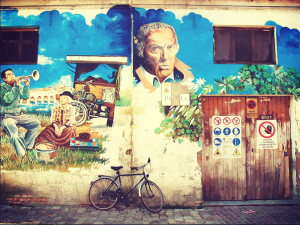The four chairs, lined up eerily outside on the cobbled street, threw me into a panic. Like one of those jokes, a candid camera scam, I felt obliged to stop and look and yet was sure that someone was watching and sniggering. I looked around, but nobody seemed to be paying much attention either to me, or to the chairs. What were four kitchen style chairs doing lined up casually on the street? They were too well kept to be waiting for the refuse, yet there they were, ownerless on the street – gazing on a hardly earth shattering vista – the brick wall of the house opposite.
Scratching my head, I wandered on. The heat of the mid-day meant that scarcely a soul stirred on the cobbled streets of Borgo San Giuliano, the old quarter, originally built for fishermen,just outside Rimini’s city centre. There’s a gentle silence during the summer afternoon here – punctuated by humming air conditioning units, and an occasional burst of shouting from someone’s frayed nerves. I went on, and stopped for a drink in a cafe that gave me a view onto the Ponte di Tiberio. Time passed, and people came and went. As the early evening arrived, an argument over football ritually broke out.

I paid up and sauntered back through the Borgo’s small streets, admiring the various murals painted as part of the Festa del Borgo – a hugely popular festival held every two years (on the even years) which sees the whole neighbourhood turned into a cross between a giant-stage and your living room, where musicians and street entertainers vie for attention, while the residents traditionally open up their doors allowing the curious to peek in; many of the murals have a Fellini theme, and in the early evening, as a priest passed me by on a bicycle, I could see why the neighbourhood was one of the Maestro’s favourites.
I turned a corner, and found myself in front of the four chairs once more – this time each regally occupied by an old woman. The quartet sat majestically surveying all who passed by – the Borgo was getting busier now, as it’s home to a number of good restaurants, and popular with locals and tourists alike – passing comment amongst themselves, taking the opportunity to enjoy some fresh air in the evening outside their resolutely non air-conditioned houses.
They seemed part of the furniture, blending in naturally and functionally to the scene. The Borgo wouldn’t have been the same without them, and vice versa. This is one of those neighbourhoods where, despite its increasing gentrification – it’s a world away from the poor and run-down quarter that greeted the turn of the 20th Century -, neighbours still gather together periodically for a ligaza, a communal meal held outside where everyone pitches up with something to add to the meal, be it a ciambella, strozzapreti, or some sangiovese wine (a ligaza is a large tablecloth which farm hands in which farm-hands and labourers would traditionally place their food tying up the ends for a makeshift parcel for ease of transport) .
They eyed me up, running my face mentally through their index-file memories of generations that had grown up and passed through the Borgo (though the process was, no-doubt, quickly interrupted when they saw my northern-European lily-white limbs), and smiled briefly as we bid each other a buona sera. It was neither friendly nor wary, but simple, courteous, and matter-of-fact – they were not surprised that a stranger would be wandering their streets. Given how beautiful those alleys and small piazzas are, it was little wonder.
The moment passed, and they returned to their discussions; stories and tales that Fellini would have given his right-ear to hear, no-doubt. I went on my way, strolling towards yet another great meal – good lord, how you can eat in Rimini! – feeling as if history, so often remote, had stepped off the page and wrapped itself warmly around me.